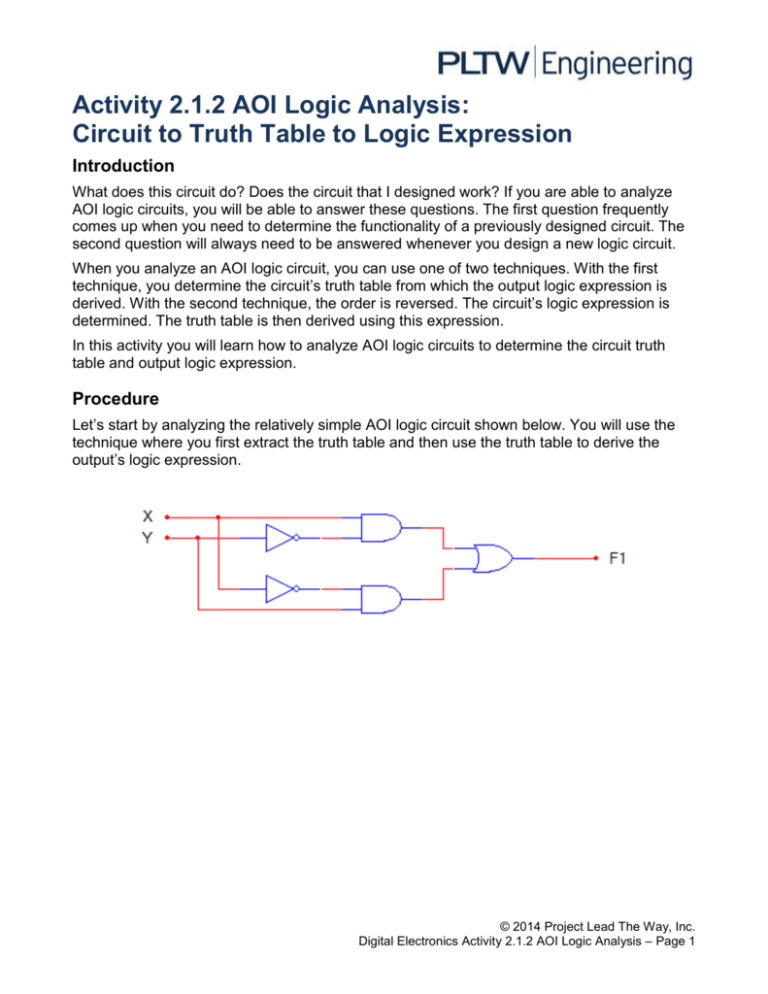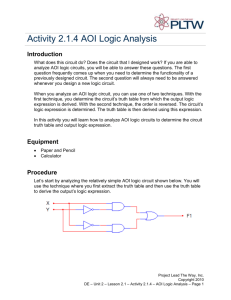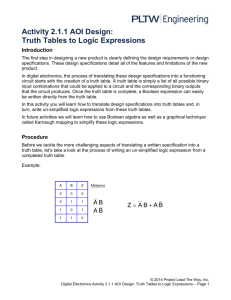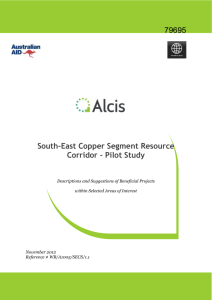Activity 2.1.2 AOI Logic Analysis: Circuit to Truth Table to Logic
advertisement

Activity 2.1.2 AOI Logic Analysis: Circuit to Truth Table to Logic Expression Introduction What does this circuit do? Does the circuit that I designed work? If you are able to analyze AOI logic circuits, you will be able to answer these questions. The first question frequently comes up when you need to determine the functionality of a previously designed circuit. The second question will always need to be answered whenever you design a new logic circuit. When you analyze an AOI logic circuit, you can use one of two techniques. With the first technique, you determine the circuit’s truth table from which the output logic expression is derived. With the second technique, the order is reversed. The circuit’s logic expression is determined. The truth table is then derived using this expression. In this activity you will learn how to analyze AOI logic circuits to determine the circuit truth table and output logic expression. Procedure Let’s start by analyzing the relatively simple AOI logic circuit shown below. You will use the technique where you first extract the truth table and then use the truth table to derive the output’s logic expression. © 2014 Project Lead The Way, Inc. Digital Electronics Activity 2.1.2 AOI Logic Analysis – Page 1 1. Using the test points that have been assigned (TP1-TP4), complete the following truth table. TP1 TP2 TP4 TP3 X Y F1 TP1 TP2 TP3 TP4 0 0 0 1 0 1 0 0 1 1 0 0 1 1 1 0 1 1 1 0 0 1 1 0 0 0 0 0 2. Using the truth table, write out the Minterms for every location that contains a (1) in the F1 column. TP1’TP2’TP3TP4 TP1TP2TP3’TP4’ 3. Using the Minterm(s), write the logic expression for the output F1. F1= TP1’TP2’TP3TP4+TP1TP2TP3’TP4’ Simplified: Re-analyze the simple AOI logic circuit using the technique where you first extract the logic expression for the output and then use the logic expression to derive the truth table. 4. Using the circuit diagram below, write the logic expression at the output of each gate until you reach the output of the circuit. © 2014 Project Lead The Way, Inc. Digital Electronics Activity 2.1.2 AOI Logic Analysis – Page 2 5. Using the logic expression, complete the truth table shown below. X Y F1 0 0 0 0 1 1 1 0 1 1 1 0 How do the logic expressions and truth tables obtained from the two techniques compare? Are they the same? They should be. If they are not, review your work and correct any mistakes. Obtaining from the second technique was much easier. The results are the same. Let’s analyze a more complex circuit. Complete the following steps for the three input AOI logic diagram shown below. © 2014 Project Lead The Way, Inc. Digital Electronics Activity 2.1.2 AOI Logic Analysis – Page 3 6. Using the analysis technique where you first extract the truth table and then use it to derive the output’s logic expression, analyze the circuit. Record your results below. R S T F2 0 0 0 0 0 0 1 0 0 1 0 1 0 1 1 0 1 0 0 1 1 0 1 1 1 1 0 1 1 1 1 1 F2 = R’ST’+RS’T’+RS’T+RST’+RST 7. Now, using the analysis technique where you first extract the logic expression for the output and then use it to derive the truth table, analyze the circuit. Record your results below. R S T F2 0 0 0 0 0 0 1 0 0 1 0 1 0 1 1 0 1 0 0 1 1 0 1 1 1 1 0 1 1 1 1 1 F2 = R’T’S+RST+RS’ © 2014 Project Lead The Way, Inc. Digital Electronics Activity 2.1.2 AOI Logic Analysis – Page 4 8. How do the truth tables obtained from the two techniques compare? Are they the same? They should be. If they are not, review your work and correct any mistakes. The truth tables are the same. 9. How do the logic expressions obtained from the two techniques compare? Are they the same? The logic expression directly from the circuit is smaller (Simplified). Compared to the one from the table which is un-simplified. 10. They are NOT IDENTICAL, but they are EQUIVALENT. In later activities we will learn how to use Boolean algebra to simplify logic expressions like these and prove that they produce the same truth table.How do the truth tables obtained from the two techniques compare? Are they the same? They should be. If they are not, review your work and correct any mistakes. 11. How do the logic expressions obtained from the two techniques compare? Are they the same? They are NOT IDENTICAL, but they are EQUIVALENT. Conclusion 1. In your own words, describe the process used to analyze a logic circuit where you first extract a truth table and then derive the logic expression. With the knowledge of the logic gates and their truth tables you can determine the truth of the out put of the total circuit. By seeing the 1 that are at the out put you add the different combinations together to give you the total result for the output. Ie. F= XYZ+Z’Y’Z’+X’YZ © 2014 Project Lead The Way, Inc. Digital Electronics Activity 2.1.2 AOI Logic Analysis – Page 5 2. Again, in your own words, describe the process used to analyze a logic circuit where you first extract the logic expression and then derive the truth table. By first getting the expression from the circuit you end up with a pre simplified equation, in wich a part will fit in many of the input combinations. Then using the expression you can determine the combinations of the truth table that fit the out put of 1 . i.e F= A’B+AB A B F 0 1 1 1 1 1 1 0 0 0 0 0 3. Did you find one of the processes easier than the other? Which one and why? I found the direct circuit to expression process easier, because it becomes alreay simplified and easier to use. 4. How can two logic equations that are not identical be equal or equivalent? Sometimes the input combinations have some parts that are the same throughout the table and can be a simple combinations like AB that apply to 2 or more. With an unsimplified equation there could be more specific to certain combination even if 2 have the same in some of the combination. © 2014 Project Lead The Way, Inc. Digital Electronics Activity 2.1.2 AOI Logic Analysis – Page 6











